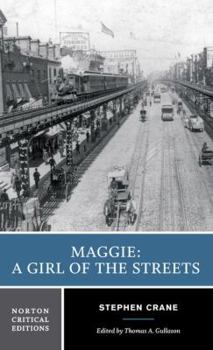Maggie: A Girl of the Streets: A Norton Critical Edition
Select Format
Select Condition 
Book Overview
This edition reprints the first published version, that of 1893.
Misprints and errors have been corrected and are identified in "A Note on the Text." Footnotes indicate changes in wording Crane made for the 1896 edition and explain slang expressions and customs of the day. Maps of the novel's New York City locales are also provided.
"Backgrounds and Sources" includes nonfictional accounts of urban life by Jacob Riis and others from...
Format:Paperback
Language:English
ISBN:0393950247
ISBN13:9780393950243
Release Date:December 1979
Publisher:W. W. Norton & Company
Length:272 Pages
Weight:0.68 lbs.
Dimensions:0.7" x 5.1" x 8.3"
Customer Reviews
3 ratings
A Blossom in a Mud Puddle
Published by Thriftbooks.com User , 16 years ago
I reread Stephen Crane's "Maggie: A Girl of the Streets" yesterday. It was the first time that I had revisited the book in almost thirty years. Originally, I read Crane's writings in a seminar course which compared his pioneering works to those of Ernest Hemingway. There were common themes in the works of both authors and they both employed a naturalistic style. Crane was more poetic, however, while Hemingway was more workmanlike in his choice of words and phrases. This tragic story takes place in the slums and the garment district. Maggie is the daughter of two alcoholic Irish immigrants. Her youngest brother dies during early childhood. Her older brother spends his youth fighting rivals in the streets and enduring beatings at the hands of his intoxicated parents at home. In adulthood, Jimmie becomes a teamster and introduces his sister to his friend Pete, a well dressed local bartender. Pete is taken with Maggie's shape and begins courting her. Eventually, Maggie quits her five dollars a week job at the cuff and collar factory and leaves home with Pete. This ill considered decision is the beginning of her ruin. Pete cares nothing for Maggie. She is a only a passing fancy. Environment determines everything in this sad tale. Alcoholic rages and casual acts of random violence occur on almost every page. Crane employs dialect to reflect the speech patterns of his characters. When Pete abandons Maggie for Nellie, a stylish prostitute, the saddest line of dialogue is Maggie's question: "Where kin I go?" Disowned by her widowed mother, who is herself a frequent defendant in the police courts on account of her drunken behavior, and brother, whose own relations with women are not much better than those of Pete, for having gone to the devil, Maggie begins walking the pavements alone and becomes one of the scarlet legions. Initially, Crane had to self publish this book since it was considered to coarse and profane to print. It proved to be unprofitable and he gave many copies of the limited first printing away. Unlike "The Red Badge of Courage," there is no place for heroism and redemption in the Bowery streets inhabited by Maggie, Jimmie and Pete. This sad account of an unfortunate woman driven into a life of prostitution is far removed from the nightly celebrations at the opulent Everleigh Club. It is humbling to think that Crane was capable of creating such a novella while he was scarcely over the age of twenty and that all of his poetry and prose was completed before his death at the age of twenty-eight.
Realistic; very sad
Published by Thriftbooks.com User , 17 years ago
Of all his works--'The Red Badge of Courage' included--Stephen Crane loved most his 'Maggie,' and for good reason. 'Maggie' is the tale of an inevitable fall from grace on the part of a young, innocent girl trapped in the vicious world of New York City's slums. Yearning for acceptance and love, beaten at home by alcoholic parents, Maggie sets out with Pete, a local bartender whose "cultured" mannerisms elicit great respect from the impressionable young girl. However, when Pete spurns her for another, Maggie is ejected out onto the street, forced into prostitution to make a living. We last see her moving off, a huge, oily fat man in tow, for a darkened corner in the city's seedy underworld. If Upton Sinclair's 'The Jungle' is a torrent of social anger and protest, Crane's 'Maggie' is like a brilliant lightning strike, flashing across our vision and leaving us temporarily blinded. The book--scarcely 70 pages--is succint, brutish, and merciless. Crane allows his readers to form their own opinions regarding the characters. His innovative use of near-phonetic spelling to depict in the reader's ear the local dialect of New York's rough neighborhoods was shocking and difficult to comprehend when the book was first released. It lends "Maggie" an air of earthy legitimacy. Ultimately, "Maggie" is a cry for the plight of poor children--the souls we overlook with a callous unease mirrored in Pete's offhand, uncaring rejection of young Maggie's genuine love and affection. It is, without qualification, Stephen Crane's greatest and most moving achievement.
Well written book about 1890's slum life
Published by Thriftbooks.com User , 20 years ago
This book was well written. The naturalistic setting and expressive use of slang transport you back to the nasty means streets of New York at the turn of the century. Some of their values seem kind of quaint and rustic as compared to 100 years later, however the realism is staggering. One can feel the despair of a terrible life that never gets better. Death and disease are the only fates that await and there is no release. This is not just a book to be read as an assignment, read it for the realistic view of history as a slice of life to understand what New Yorker's were going through then, and as a parable to ghetto life today. Some things have changed but some still stay the same......plus ca change.......






